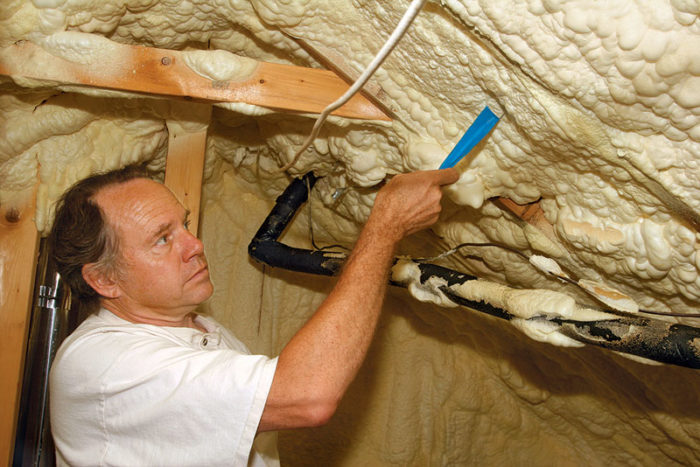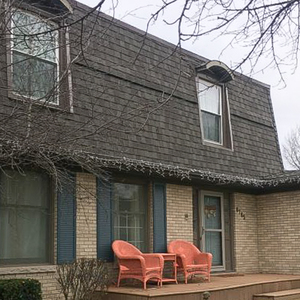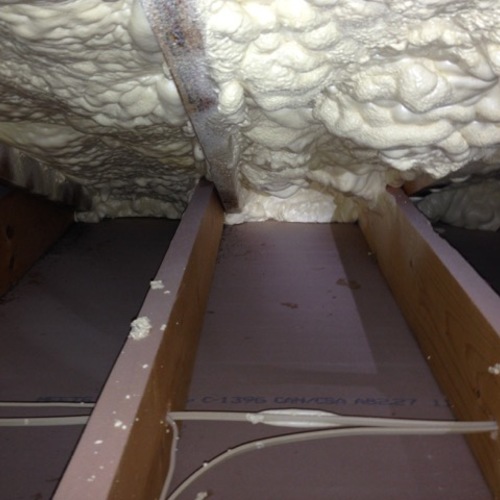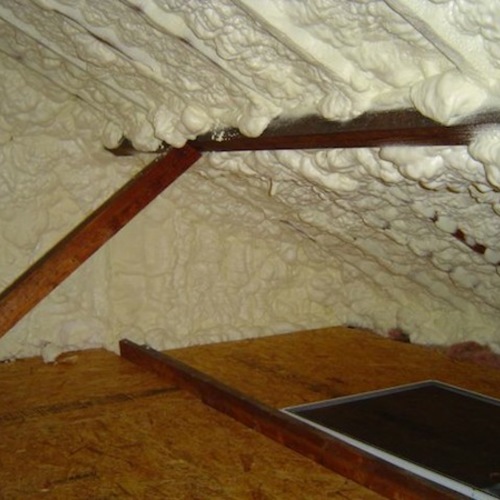
Image Credit: Image #1: Fine Homebuilding
If you convert your vented unconditioned attic to an unvented conditioned attic by installing open-cell spray foam on the underside of your roof sheathing, you may be surprised to discover that your attic is now the most humid room in your house.
Why? We don’t know. Although building scientists haven’t achieved a consensus on the answer, we do have enough information to paint a picture of what’s going on.
Consistent reports from homeowners and builders
Lots of GBA readers have posted reports of this type of problem. Here is a sampling:
Weekly Newsletter
Get building science and energy efficiency advice, plus special offers, in your inbox.

This article is only available to GBA Prime Members
Sign up for a free trial and get instant access to this article as well as GBA’s complete library of premium articles and construction details.
Start Free TrialAlready a member? Log in















26 Comments
What about active ventilation
Martin, I noticed that you sometimes recommend installing a small fan in conditioned crawlspaces to help exhaust humid air. Would a similar strategy help in situations where a conditioned attic is experiencing unacceptably high levels of humidity? Is there also a role for whole-house dehumidification? Would these measures help home owners to mitigate risk if they have a conditioned attic with open cell foam?
New versus existing construction
Thanks Martin for another excellent article on this complicated subject. All your reader examples and some of your wording pertains to existing home conversion problems. New homes tend to have better vapor barriers at the ground, are more airtight and have better spot exhaust systems. I know this doesn't explain why open cell still seems to have more problems than closed cell but wonder how much the quality of housing stock makes a difference.
Open cell foam at the bottom of roof OSB has become common in the south and most projects don't provide dedicated ventilation. With so many projects in the field that seem to be doing fine, what are we to make from the lack of attention on such a widespread issue? For now, I'm more inclined to follow Allison's advice and avoid open cell for zones 5 and up. http://www.energyvanguard.com/blog-building-science-HERS-BPI/bid/75042/Will-Open-Cell-Spray-Foam-Insulation-Really-Rot-Your-Roof
Perhaps more monitoring and cases of failure will reinforce your recommendations for new construction. Certainly all these issues are good reasons to stick with traditional unconditioned attics (with no HVAC in them) and insulative sheathing above the roof deck.
Response to Steve Knapp (Comment #1)
Steve,
In theory, if you install a small exhaust fan in the gable wall of an unvented attic, along with a passive duct or grille that allows conditioned air from the floor below to enter the attic as makeup air, the humid air in the attic will be exhausted and will be replaced with less humid air from the home. That should help.
For more information on your question, see Comment #7 by Joe Lstiburek, below.
Response to Brian Knight (Comment #2)
Brian,
You're right that many attics insulated with open-cell spray foam insulation don't have humidity problems. Some of these attics are probably being conditioned accidentally (due to leaky ductwork in the attic). Others may be being protected by other means that remain unclear.
I spoke to many researchers and industry experts when I investigated this topic, and none of them, including Rick Duncan, the technical director of the Spray Polyurethane Foam Alliance, ever told me, "We don't think this is a problem."
mineral wool, too?
Great, detailed article. Why wouldn't mineral wool insulation also create a similar attic humidity problem unless the moisture-storing capabilities of the open-cell insulation is the significant cause. Or maybe mineral wool also has this issue?!
Response to Steve Hall
Steve,
It is a code violation to install an air-permeable insulation like mineral wool or fiberglass on the underside of the roof sheathing to create an unvented insulated roof assembly -- unless there is an adequately thick layer of rigid foam on the exterior side of the roof sheathing.
Code change proposal
I have a proposed code change coming up in Kansas City addressing some of the comments raised by your readers. The language is below. The foam folks totally hate this. I'm trying to help them with a problem that they deny is occurring. They are fighting this tooth and nail.
“5.1.5. In climate zones 1, 2 and 3 air shall be supplied at a flow rate greater than or equal to 50 cfm per 1000 ft2 of ceiling. The air shall be supplied from ductwork providing supply air to the occupiable space when the conditioning system is operating. Alternatively one of the following shall occur:
1) air shall be supplied to the attic by a fan blowing air from the occupiable space into the attic.
2) transfer air from the occupiable space shall be provided by a fan exhausting attic air to the outside, or
3) mechanical dehumidification shall be provided to the unvented attic air space.”
Response to Martin Holladay
Martin,
Thanks for your response. I'm sorry, I didn't completely state my assumptions: The mineral wool would be covered with a vapor barrier like paper, felt, or membrane and then drywall. (There could also be a 2" gap between the wool and wood roof sheathing for old code soffit-ridge ventilation, but that's a little beyond my question.) In effect, this construction has similar insulating and vapor control properties of open cell foam. Wouldn't it also create the same humid attic condition?
Here in NC, I see a lot of attic renovations. Tiny 2x6 stick rafters at a steep slop are not enough for proper insulation. My personal bias against the flammability of spray foam in wood, residential, and potentially recessed lighting/gas flue-penetrated buildings aims me toward mineral wool/fiberglass in appropriate thicknesses. (Usually obtained only with more furring.) I just want to understand if this construction might be susceptible to additional humidity load on the HVAC and potential condensation issues since we are always so close to dew point in this region.
Response to Steve Hall
Steve,
The type of roof assembly that you are describing is illegal -- it does not meet code -- unless it includes a ventilation channel between the top of the insulation and the underside of the roof sheathing.
Once you include this ventilation channel, along the with requisite soffit vents and ridge vents, then you have solved the problem of moisture build-up (because the air flow through the vent channel carries away excess moisture and helps the sheathing to stay dry).
For more information on all of the different code-approved ways to insulate a sloped roof assembly, see this article: How to Build an Insulated Cathedral Ceiling.
Ping-pong water
The sorption and desorption rates in the roof sheathing vary. Hysteresis is a well-known phenomenon with hygroscopic porous materials. That is where the non-linearity and ratcheting Dr. Walker alludes to comes from. I refer to this as “ping-pong” water. Each pong is not matched by an equal ping.
Ping-pong water is far more elegant an expression than non-linearity and hysteresis. This is the basis of the accumulation. Now once the moisture exits the foam and gets into the air it ends up at the ridge due to it being both warmer and less dense (“hygric buoyancy”). This happens on a daily basis. The sheathing away from the ridge never gets anywhere near its equilibrium moisture content so it can keep cycling endlessly. The air change between the attic and the house provide a continuous source of new water molecules and this cycle transports them up to the ridge.
For the record I do not have a problem with low-density foam. We have an engineering solution to the observed phenomena that has been demonstrated to work. The explanation is less important than solving the problem. You can use low-density foam in attics both north and south. But they have to be conditioned. Period.
Response to Joe Lstiburek (Comment #7)
Joe,
Thanks for sharing the language of your proposed code change proposal concerning unvented attics insulated with open-cell spray foam.
The proposal you shared doesn't address the fire safety concerns that have been raised relating to the installation of forced-air registers or return-air grilles in attics with spray foam that lacks a layer of 1/2-inch drywall. Are you also proposing code changes to address those issues?
Response to Joe Lstiburek (Comment #10)
Joe,
I'm going to continue to be more conservative than you when it comes to providing recommendations to builders who want to install open-cell spray foam to create an unvented attic -- at least until the code issues are settled in regards to smoke spread through forced-air ductwork and the unresolved questions concerning whether exposed spray foam needs to be protected by a layer of drywall.
Response to Martin Holladay #9
Martin,
I mentioned a 2" ventilation channel. That would be my intent to meet code. Oddly, the article you reference also questions the usefulness of this ventilation, regardless of the legal requirement.
The issue in that other article is ceiling air-tightness, and I'm wondering if that is exactly the issue in this article with open cell foam... just as it would be with mineral wool. Neither solve the issue of higher attic humidity without an air-tight vapor barrier. (Polyethylene?)
Response to Steve Hall
Steve,
It's certainly true that an airtight ceiling is a prerequisite for any high-performance cathedral ceiling, and that most cathedral ceiling failures are due, at least in part, to air leakage. That's why most building science experts teach builders than an airtight ceiling is more important than a perfect ventilation channel.
That said, there is no doubt that the presence or absence of a ventilation channel can spell the difference between success and failure -- which is why the code won't allow you to install mineral wool or fiberglass up against roof sheathing unless there is an adequately thick layer of rigid foam on the exterior side of the roof sheathing.
If you've been talking about vented roof assemblies all along -- and by the way, that wasn't clear in your first posted comment (Comment #5) -- then the type of vented roof assembly you are talking about does not resemble the humid assemblies discussed in this article.
As I wrote in Comment #9, "Once you include this ventilation channel, along the with requisite soffit vents and ridge vents, then you have solved the problem of moisture build-up (because the air flow through the vent channel carries away excess moisture and helps the sheathing to stay dry)."
Remember, in one of the bullet points at the end of my article, I pointed out, "If a roof has simple geometry allowing soffit-to-ridge venting, one way to reduce the risk of open-cell spray foam is to install ventilation baffles between the underside of the roof sheathing and the open-cell spray foam."
In my view, the problems in the attics discussed in this article have nothing to do with ceiling airtightness (although Iain Walker speculated that air leakage may have something to do with what's going on). As I noted in a different article, Air Leakage Through Spray Polyurethane Foam, open-cell spray foam only needs to be 3 or 3.5 inches thick to form a decent air barrier.
In these humid attics, the moisture is getting through the open-cell spray foam by vapor diffusion, not via air leakage.
Process of elimination?
Hmm...
I think we can eliminate some possibilities: if attics with cut&cobble with closed cell (or any other really good vapor barrier) & a further layer of open cell foam never display this problem, then it is clearly not hygric buoyancy or any other interior source and, therefore, must be due to moisture driven inward.
Anyone with anecdotal evidence?
Response to Dustin Harris
Dustin,
I disagree with your analysis.
Joe Lstiburek and Kohta Ueno are saying that high levels of interior moisture end up in the attic because of hygric buoyancy. They also assert that this moisture is stored in cold roof sheathing, especially at night.
If the roof sheathing is protected on the interior by a layer of vapor-impermeable cut-and-cobble foam, then the moisture in the attic air is decoupled from the roof sheathing. The rigid foam prevents the migration of moisture from the attic air to the cold roof sheathing.
That's why (according to Lstiburek and Ueno) this phenomenon isn't observed in attics insulated with closed-cell spray foam or the cut-and-cobble approach.
I'm not sure why you have concluded that "it is clearly not hygric buoyancy or any other interior source." (You may be right -- but I don't understand your logic.)
Behavior of wood as a reservoir
I think that it helps to think about what the wood in the roof deck might be doing as far as moisture exchange. The curve of equilibrium moisture content vs. humidity for wood has a moderate slope up to somewhere around 12% moisture and 80% humidity. Then it becomes extremely steep, with the wood able to take on a lot more moisture for only small changes in humidity. A good simplified way to think about this is that once the wood gets pretty wet, it will maintain almost constant 80% humidity. That sounds like a stabilizing effect, except that the temperature of the roof deck swings very widely. Perhaps in the summer it gets down to 60 F at night and up to 140 F during the day. At 60 F, the vapor pressure of water for 80% humidity is about 10 torr, or 1.5% of atmospheric pressure. At 140 F, 80% humidity corresponds to 120 torr, or 16% of atmospheric pressure. If the attic is at 80 F and 80% humidity, that's about a 21 torr vapor pressure of water. So compared to that hot humid attic, the vapor pressure at the other side of the foam is a factor of six higher. So it certainly makes sense that that vapor would rapidly diffuse through the foam and make the attic even more humid once the sun hits the roof deck.
So that aspect of the behavior--the attic getting humid on sunny days--is easy to explain. In fact, if we want the attic to be at 50% humidity and 80 F, and have the roof deck at 140 F, and have no moisture drive coming from the deck into the attic, we'd need the roof deck to be at less than 10% humidity!
The other question though is why does this get worse over time--is there a "ratcheting" effect? Hysteresis doesn't directly explain ratcheting. You could summarize hysteresis as dry stuff not accepting moisture as fast as you'd expect and wet stuff holding on to moisture more than you'd expect. Hysteresis actually inhibits the extent of the ping pong effect. Given that we have several nonlinearities--the vapor pressure vs. temperature, and the wood moisture content vs. humidity and temperature--it's hard to rule out ratcheting, but I'm not convinced that it exisits.
But reports are that it gets worse over time, so how does that happen? I think that works more on a seasonal cycle than a daily cycle, and has to do with the stack effect. In the winter, any small air leaks in the attic, probably not through the foam but elsewhere, leak air out, and the warm humid air from the conditioned space refills the attic, providing a fresh supply of humidity that can replenish the reservoir of humidity in the roof deck.
In the summer, the stack effect is reversed, and attic air leaks have outside air coming in. The outside air might not be any higher humidity than the air that is in the attic already, but it at least means that conditioned air from downstairs is unlikely to get into the attic to help things out, unless it's deliberately introduced.
One kind of ratcheting effect I could see happening is with a smart vapor retarder. But the ratcheting would be in the other direction! When the deck is creating high vapor pressure, the inside of the smart membrane would see high humidity and open up, releasing the "steam". But at night, as long as the attic humidity stayed reasonable, the smart membrane wouldn't let that moisture get sucked back in as rapidly. That seems like a pretty good solution. But not as good a solution as providing vent space above the insulation, above or below the roof deck.
Actually, it is necessary for
Actually, it is necessary for the wood to hold onto moisture longer, the ping in is greater than the pong out. That is how we get the accumulation over time. And when the pong out happens it moves upward. And yes there is a seasonal difference as well as a daily cycle and of course a climatic difference and a roofing cladding difference and a roof coloring difference and an orientation difference and an elevation difference.
Apparently there are no smoke issues or fire issues when ductwork is leaky and ceilings are leaky to poor workmanship. But when we have tight ducts with a smaller amount of supply air than was present with leaky ducts there is a problem? Welcome to code world. Now, in code world supplying air to the attic is ok - returning it is not ok. Exhausting air from the attic to the outside resulting in a negative pressure in the attic causing air to be pulled from the house into the attic is also ok. So my code changes are ok in code world. In the real world they result in a safer building and one that is free from moisture problems. We shall see how it goes in Kansas City in October.
Hi Joe- how do we exhaust the air from the unvented attic? What's the best method. Would a humidity sensing bathroom exhaust fan installed in the attic and ran to the outside work? Thanks!
What about the metal roof example?
I was surprised to see a metal roof among the examples in the intro to this article. Why shouldn't I expect the metal to prevent (or at least mitigate) moisture communication of the attic with the exterior? And in general are there differences one should expect to see with respect to this particular problem when the roof is a standing seam metal roof, for example (or has one of those peel and stickpolymeric layers under shingles)?
Response to Antonio Oliver
Antonio,
Most of the researchers looking into this problem think that the moisture in these attics is interior moisture, not exterior moisture. Whether or not the roofing is vapor-permeable (most types of roofing are not) is irrelevant.
In other words, this isn't rain. This isn't dew. This probably isn't moisture piggybacking on infiltrating air. This is moisture whose origin is inside the house.
Somehow, the moisture that is present in interior air is migrating to the attic and concentrating there.
“[Deleted]”
Thanks for the detailed article. I'm experiencing this problem in CZ4a. It seems like the ingredients are here from the experts, but some amount of mismatched terminology and assumptions.
On a day with the A/C running (AHU in attic), temp stratification appears to be induced by conductive cooling by the ductwork and AHU, driving up the dew point at the ridge. Once the hot, humid air gets to the peak, it has nowhere to go without mechanical ventilation. I took an Extech HD500 psychrometer into the attic on representative days with and without A/C to corroborate my RH&T datalogger. With A/C operation there's both a dew point and temp gradient from floor to ridge. With A/C off there was a 4ºF DP gradient, while dry bulb temp was uniform (within 1º). That was on a sunny, relatively dry day (82º, 62º DP) following a few days of consistent A/C operation, so it could be that moisture was still being released from the rafters and roof deck.
Today I discovered that the duct for the inline exhaust fan I'm using was disconnected. It was drawing air from 2 ft off the floor instead of the ridge (6 ft). So maybe my results will change. Last summer I experimented with a dehumidifier, but that's not a very satisfactory solution from an energy use standpoint.
To Martin's final point in the article, it seems like most of the solutions to this problem have a high probability of failure, potentially leading to knock on problems. A lot of attics don't get checked for years, and a mechanical device like a fan or dehumidifier could be broken for a long time before being detected. Adding conditioned air seems like a good idea, though I suspect you could still have stratification depending on how effective mixing is, and how frequently the system runs. And when in the day.
"One possible solution to the humid-attic problem is to install a forced-air supply register (and perhaps a return-air grille) in the attic. Note, however, that this solution violates the building code unless the spray foam is protected by a layer of drywall."
Does painted drywall definitively solve the humidity problem? I don't want to do that as an exploratory solution...
"If a roof has simple geometry allowing soffit-to-ridge venting, one way to reduce the risk of open-cell spray foam is to install ventilation baffles between the underside of the roof sheathing and the open-cell spray foam. This solution won’t work, however, on a hip roof or a roof with valleys, dormers, or skylights."
I have Accuvent baffles, though under an unvented slate Gambrel roof, so probably not the scenario you're suggesting. The SPF is mostly contacting the plastic baffles and rafters and hardly any of the roof deck. The rafters are 16" OC, so probably more rafter contact than with a typical asphalt shingle roof.
Thank you for this great summary of the situation.
I am in Florida and remodeling my house. Would it be a viable solution to just install a standalone dehumidifier in the attic that has open-cell spray foam on the underside of roof sheathing instead of a AC supply register.
Thank you
Niko
Yes, a standalone dehumidifier will work. The cheap ones can be noisy though, and the energy cost may be higher than simply allowing the A/C to do its thing. One of the dehumidifiers from Santa Fe might be a better choice. If going that route, I would probably set it at about 70% or even as high as 80% if there's nothing in the attic that will be damaged by humidity. That's still low enough to prevent mold growth. If there is A/C ductwork in the attic you might find that lower humidity is required to prevent condensation on the ductwork. Then again, if there's A/C ductwork in the attic it's probably better and easier to just open up a small supply and return register.
Peter,
" I would probably set it at about 70% or even as high as 80% if there's nothing in the attic that will be damaged by humidity."
I'm not sure that's at all true. Isn't the article's whole point is that excess attic humidity can cause problems for the sheathing.
Log in or become a member to post a comment.
Sign up Log in